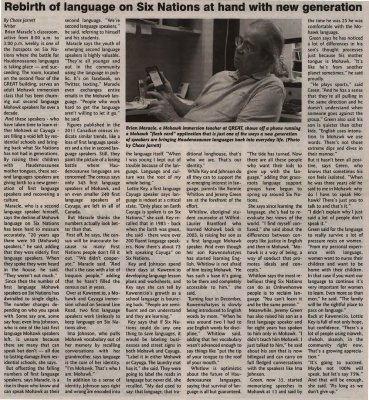"Rebirth of language on Six Nations at hand with new generation"
- Publication
- Turtle Island News, 28 Nov 2012
- Full Text
- Rebirth of language on Six Nations at hand with new generationBy Chase Jarret, Writer
Brian Maracle's classroom, active from 8:00 a.m. to 3:00 p.m. weekly, is one of the hotspots on Six Nations where the battle for Haudenosaunee languages is taking place - and succeeding. The room, located on the second floor of the GREAT building, serves an adult Mohawk immersion class that has been churning out second language Mohawk speakers for over a decade.
And these speakers - who have taken time to learn either Mohawk or Cayuga are filling a void left by residential schools and bringing back what Six Nations has not had in generations. By raising their children with Haudenosaunee mother tongues, these second languages speakers are giving birth to a new generation of first language speakers and recovering a culture.
Maracle, who is a second language speaker himself, says the decline of Mohawk language on Six Nations has been hard to measure accurately. "20 years ago there were 50 (Mohawk) speakers," he said, adding that they were elderly, first language speakers. When they spoke they were heard in the house, he said.
"They weren't out much."
Since then the number of first language Mohawk speakers on Six Nations has dwindled to single digits. The number changes depending on who you speak with. Some say one, some say four, even Ima Johnson, who is one of the last first language Mohawk speakers left, is unsure because there are many that can speak but don't - all due to lasting damage from residential schools, she says.
But offsetting the falling numbers of first language speakers, says Maracle, is a rise in those who know and can speak Mohawk as their second language. "We're second language speakers," he said, referring to himself and his students.
Maracle says the youth of emerging second language speakers is highly valuable.
"They're all younger and out in the community using the language in public. It's on Facebook, on Twitter, texting." Maracle even exchanges entire emails in the Mohawk language. "People who work hard to get the language aren't willing to let it go," he said.
Figures published in the 2011 Canadian census indicate similar trends, like a loss of first language speakers and a rise in second language speakers. Still, they paint the picture of a losing battle where Haudenosaunee languages are concerned: The census says only 545 first language speakers of Mohawk, and an even smaller 240 first language speakers of Cayuga, are left in all of Canada.
But Maracle thinks the numbers actually look better than that.
First off, he says, the census will be inaccurate because so many First Nations people don't fill it out. "We didn't cooperate," Maracle said. "And that's the case with a lot of Iroquois people," adding that he hasn't filled the census out in years.
Over at Kawenni:io, a Mohawk and Cayuga immersion school on Second Line Road, two first language speakers work tirelessly to keep language on Six Nations alive.
Ima Johnson, who pulls Mohawk vocabulary out of her memory by recalling conversations with her grandmother, says language is the core of her identity. "I'm Mohawk. That's who I am. Mohawk."
In addition to a sense of identity, Johnson says right and wrong are encoded into the language itself. "When I was young I kept out of trouble because of the language. Language and culture was the root of my whole being."
Lottie Key, a first language Cayuga speaker says language is indeed at a critical state. "Only place on Earth Cayuga is spoken is on Six Nations," she said. Key recalled that in 1983 - back when the Earth was green, she said - there were over 200 fluent language speakers. Now there's about 75 left speaking Cayuga" on Six Nations.
Key and Johnson spend their days at Kawenni:io developing language lesson plans and worksheets, and Key says she can tell by Kawenni:io's growth as a school language is bouncing back. "People are semifluent and can understand and they are learning."
Key says that if Six Nations could do any one thing to save languages, it would be labeling businesses and street signs in both Mohawk and Cayuga.
"Label it in either Mohawk or Cayuga. The laundry mat has it," she said. They were going to label the roads in language but never did, she recalled. "My dad used to say: that language, that traditional longhouse, that's who we are. That's our identity."
While Key and Johnson do all they can to support the re-emerging interest in language, parents like Bonnie Whitlow and Jeremy Green are at the forefront of the effort.
Whitlow, aboriginal student counselor at Wilfrid Laurier Brantford who learned Mohawk back in 2003, is raising her son as a first language Mohawk speaker. And even though her son Rawennahatyes has started learning English, Whitlow is not afraid of him losing Mohawk. "He has such a base it's going to be there and completely accessible to him," she said.
Turning four in December, Rawennahatyes is slowly being introduced to English words by mom. "When he was around two I had to use English words for discipline," Whitlow said, adding that her vocabulary wasn't advanced enough to say things like "put the tip of your tongue to the roof of your mouth."
Whitlow is optimistic about the future of Haudenosaunee languages, saying that survival of language is all but guaranteed.
"The tide has turned. Now there are all these people who want their kids to grow up with the language," adding that grassroots language support groups have begun to spring up around Six Nations.
She says since learning the language, she's had to re-evaluate her views of the world. "I find myself confused," she said about the differences between concepts like justice in English and then in Mohawk. "Mohawk is a way of being, a way of conduct that promotes ideals and concepts."
Whitlow says the most rebellious thing Six Nations can do as Onkwehonwe people is to reclaim language. "You can't learn it and be the same person."
Meanwhile, Jeremy Green has also raised his son as a first language speaker and for eight years has spoken to him only in Mohawk. "I didn't teach him Mohawk, I just talked to him," he said about his son that is now bilingual and can carry on full fledged conversations with the speakers like Ima Johnson.
Green, now 35, started memorizing speeches in Mohawk at 13 and said by the time he was 25 he was comfortable with the Mohawk language.
Green says he has noticed a lot of differences in his son's thought processes just because his mother tongue is Mohawk. "It's like he's from another planet sometimes," he said proudly.
"He plays sports," said Green. "And he has a sense that they're all pulling in the same direction and he doesn't understand when someone goes against the group." Green also said his son is quieter than other kids. "English uses intonation. In Mohawk we use words. There's not those extreme dips and dives in their manner."
But it hasn't been all positive, says Green, who knows that sometimes his son feels isolated. "When he was three years old he said to me in Mohawk: why do I have to speak Mohawk? There's just you to talk to and that's it."
"I didn't explain why I just said a lot of people don't speak it."
Green said for the language to really survive a lot of pressure rests on women.
"From my personal experience with language, women want to nurse their children and want to be home with their children. In that case if you want our language to continue it's very important for women to learn. Even more so than men," he said. "The family will be the rightful place to pass on language."
Back at Kawenni:io, Lottie Key is full of not only hope, but confidence. "There's a lot of people using niaweh, shekoh, skanoh, in the community right now. That's a growing appreciation."
"It's going to succeed. Maybe not 100% will speak, but let's say 75%." And that will be enough, she said. "As long as we don't give up."
- Creator
- Jarrett, Chase, Author
- Media Type
- Text
- Newspaper
- Item Type
- Clippings
- Publisher
- Turtle Island News
- Place of Publication
- Six Nations of the Grand River, ON
- Date of Publication
- 28 Nov 2012
- Subject(s)
- Personal Name(s)
- Maracle, Brian ; Johnson, Ima ; Key, Lottie ; Whitlow, Bonnie ; Green, Jeremy.
- Corporate Name(s)
- Grant River Employment and Training ; Wilfried Laurier University ; Kawenni:io/Gaweni:yo Private School.
- Local identifier
- SNPL004520v00d
- Language of Item
- English
- Geographic Coverage
-
-
Ontario, Canada
Latitude: 43.0705251167401 Longitude: -80.1154058624268
-
- Creative Commons licence
 [more details]
[more details]- Copyright Statement
- Public domain: Copyright has expired according to Canadian law. No restrictions on use.
- Copyright Date
- 2012
- Copyright Holder
- Turtle Island News
- Contact
- Six Nations Public LibraryEmail:info@snpl.ca
Website:
Agency street/mail address:1679 Chiefswood Rd
PO Box 149
Ohsweken, ON N0A 1M0
519-445-2954



